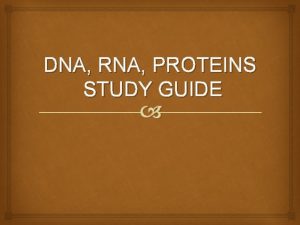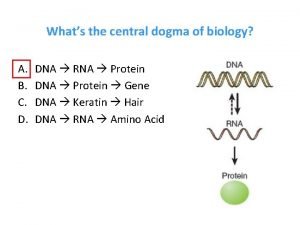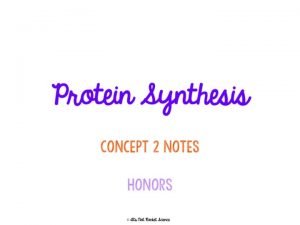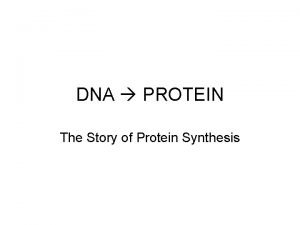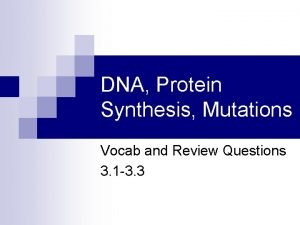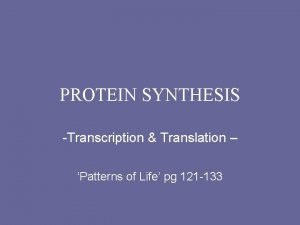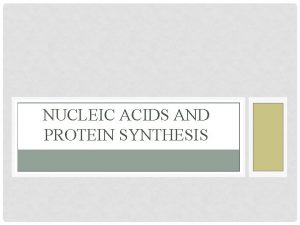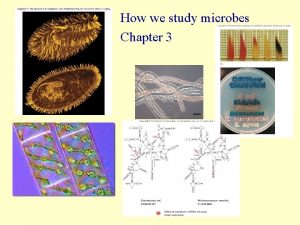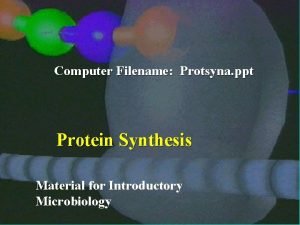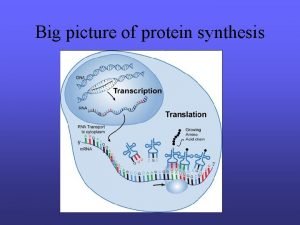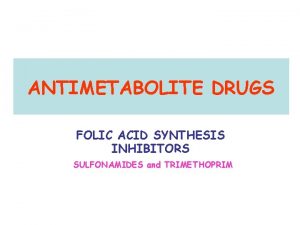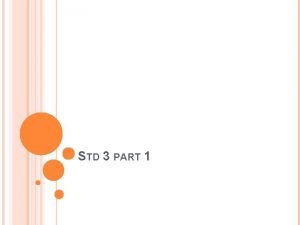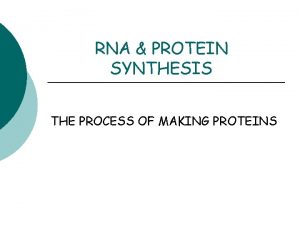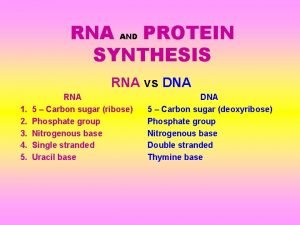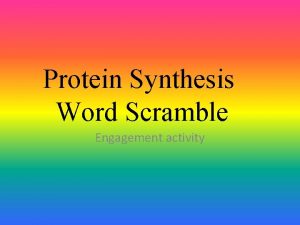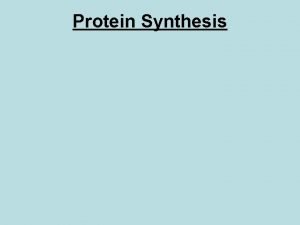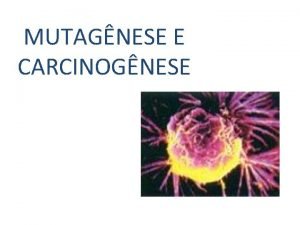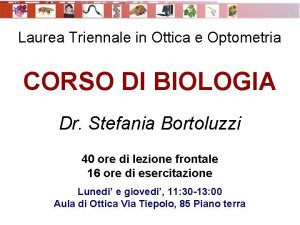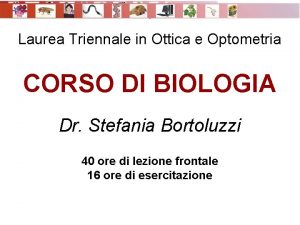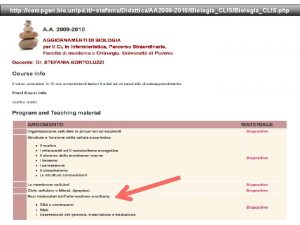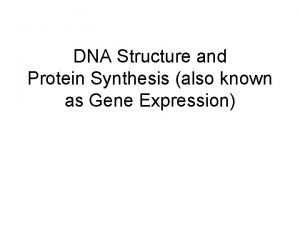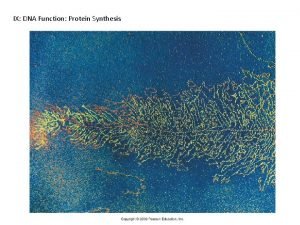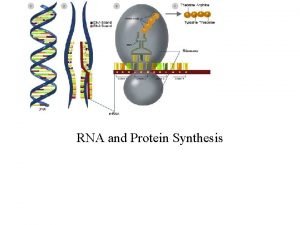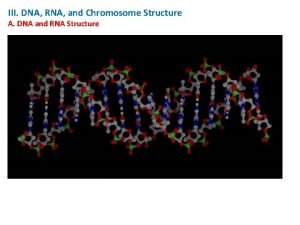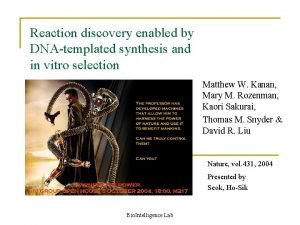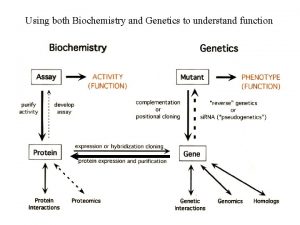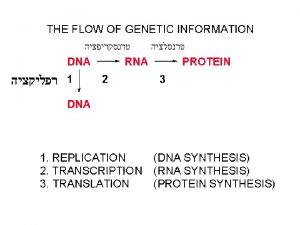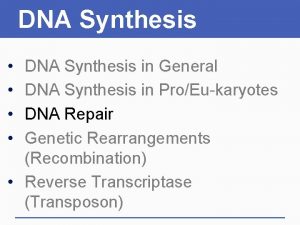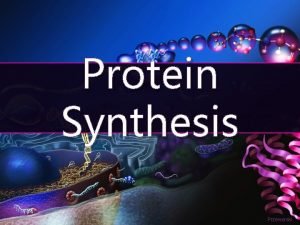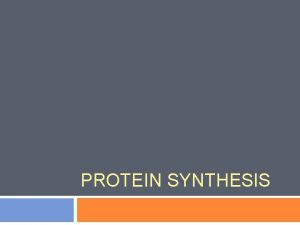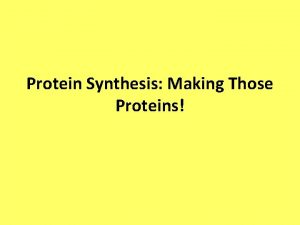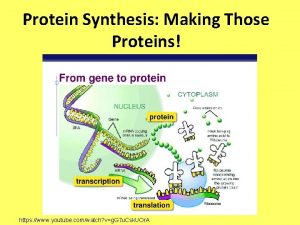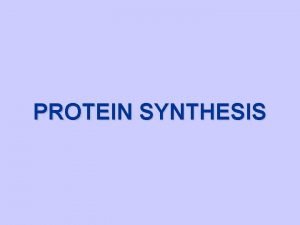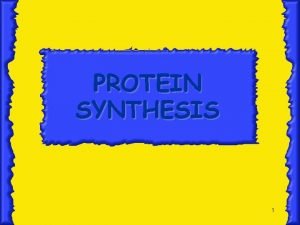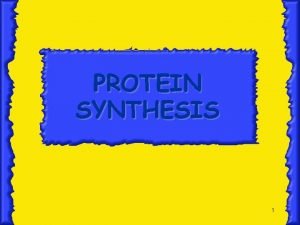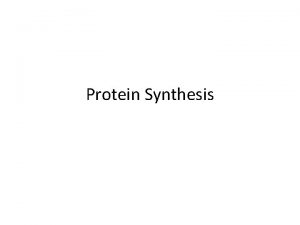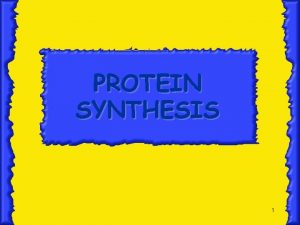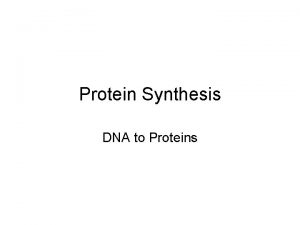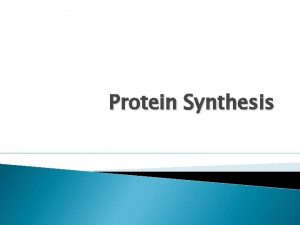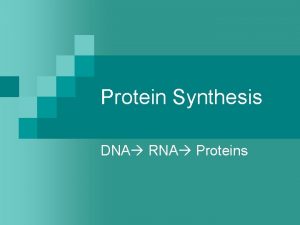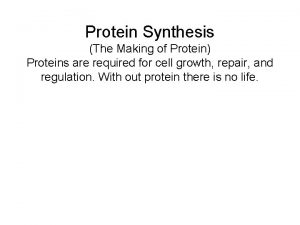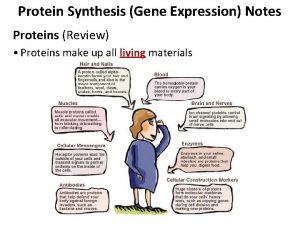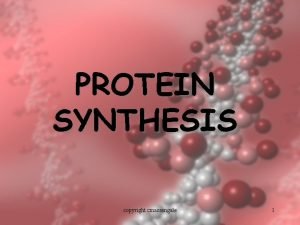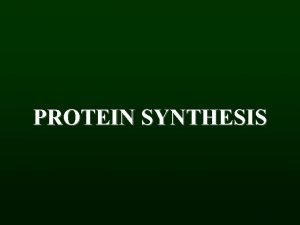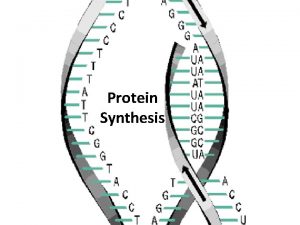Protein Synthesis Making Those Proteins Review DNA Hershey














































- Slides: 46

Protein Synthesis: Making Those Proteins!

Review: DNA Hershey and Chase’s experiment showed that DNA was the genetic material

So What are Proteins? • Proteins are the “work-horses” of the cell…they do a lot of different jobs! A) Antibodies – immune system (defense) B) Structure – hair and nails C) Speeding Up Reactions – enzymes D) Transport – hemoglobin (in blood) E) Movement – muscle And the list goes on!

Question: Why do these proteins all have different shapes?

How do our cells make proteins? • DNA contains genes, sections of nucleotide chains • Genes code for polypeptides (proteins) • Polypeptides are amino acid chains

• DNA is found inside the nucleus, but proteins are made in ribosomes • Predictions: So how do we get the message from DNA in the nucleus to the ribosomes?

The Solution? • A molecule called RNA carries the message from the nucleus to the cytoplasm! • Unlike DNA, RNA is small enough to fit through the pores in the nuclear membrane

Roles of DNA and RNA • DNA is the master plan • RNA is the copy of the master plan!

Differences between RNA and DNA #1: Number of Strands -DNA Double -RNA Single Question: 1) Why might RNA mutate (shuffle its bases) more easily than DNA? 2) Do you think the HIV is an RNA or DNA virus?

#2: Nitrogen bases -DNA Thymine (T) -RNA Uracil (U) #3: Sugars -DNA deoxyribose -RNA ribose

Question: What base does Uracil pair with?

3 Types of RNA • Messenger RNA (m. RNA) copies DNA’s code & carries it to the ribosome • Transfer RNA (t. RNA) takes amino acids to the ribosomes, where they can be joined into a chain • Ribosomal RNA (r. RNA) makes up the ribosomes

Messenger RNA (m. RNA) • Long Straight chain of Nucleotides • Made in the Nucleus • Copies DNA & leaves through nuclear pores • Contains the Nitrogen Bases A, G, C, U ( no T )

Transfer RNA (t. RNA) • Clover-leaf shape • Has an attachment site at one end for an amino acid…each t. RNA carries a specific amino acid

Ribosomal RNA (r. RNA) • Globular in shape • Together with proteins, makes up ribosomes

Protein Synthesis • Process of making proteins…. 2 parts 1) Transcription 2) Translation ?

Part 1: Transcription • m. RNA picks up the code from the DNA template strand takes it from the nucleus to ribosomes in the cytoplasm • Main goal: make a copy of the code and get it out of the nucleus! Question: Why can’t DNA leave the nucleus?

Steps of Transcription 1) DNA unzips 2) RNA polymerase (an enzyme) matches RNA bases with DNA template to make a strand 3) m. RNA is released and leaves through the nuclear pore Question: How is this similar to replication?

RNA Free Nucleotides RNA Polymerase DNA

Let’s Transcribe! Let’s transcribe an m. RNA molecule from a DNA template strand… DNA A C T G G C A A T C G C m. RNA

Part 2: Translation • The instructions (m. RNA) are read by t. RNA, and t. RNA joins amino acids in the right order in the ribosome • Main Goal: make a polypeptide!

Steps of Translation 1) m. RNA goes to the ribosome 2) t. RNA brings amino acids to the ribosome 3) t. RNA “reads” the m. RNA instructions and puts the amino acids in the right order 4) Amino acids link together by peptide bonds to make a polypeptide (protein) How does t. RNA “read” the m. RNA instructions?

t. RNA…”The Reader” 3 bases on m. RNA strand = codon 3 bases at bottom of each t. RNA = anticodon Question: What anticodon matches with these codons? 1) A U C 2) G C A m. RNA t. RNA anticodon

More complementary base pairing…HOW THRILLING!

Ribosome m. RNA

Let’s See Translation in Action! aa 1 U A C A U G aa 2 G A U C U A C U U C G A

peptide bond aa 1 aa 3 aa 2 G A A U A C A U G G A U C U A C U U C G A

aa 3 aa 1 aa 2 G A A (leaves) A U G G A U C U A C U U C G A

aa 1 aa 4 aa 2 aa 3 G C U A U G G A U G A A C U U C G A A C U

aa 1 aa 4 aa 2 aa 3 (leaves) A U G G C U G A A C U U C G A A C U

aa 1 aa 5 aa 2 aa 3 aa 4 U G A A G C U A C U U C G A A C U

aa 5 aa 1 aa 2 aa 3 aa 4 U G A (leaves) G C U A C U U C G A A C U

aa 4 aa 3 aa 5 aa 199 aa 200 Stop Codon says STOP TRANSLATING! aa 2 aa 1 A C U C A U G U U U A G

Let’s see translation in action! http: //www. youtube. com/watch? v=B 6 O 6 u. R b 1 D 38

• Scientists can “read” the m. RNA by using a “codon” table that matches codons with their amino acids Start Codon: AUG Stop Codons: UAA, UAG, UGA

Codon charts can look different from one another but be used for the same thing! Use the m. RNA strand codon chart in your notes to make an amino acid chain!

End Result of Transcription and Translation • A beautiful polypeptide that can fold into a protein and do an important job in the cell!

Pathway to Making a Protein DNA Transcription m. RNA t. RNA (ribosomes) Protein Translation

Revisiting our Video • Now that we’ve learned about transcription and translation, let’s make some changes to our observations by watching the video again! http: //www. youtube. com/watch? v=983 lhh 20 r. GY http: //www. youtube. com/watch? v=4 PKj. F 7 Oum. Yo

An Analogy to Help You Remember. Baking a Cake • DNA = Recipe book at the library • m. RNA = Handwritten copy of recipe • t. RNA = You (read recipe and put ingredients together) • Ribosome = Kitchen • Amino Acids = Ingredients • Polypeptide = CAKE!!!!

Make Your Own Analogy • Must have a comparison for 4 of the following things: DNA, m. RNA, t. RNA, ribosome, amino acids, polypeptide • Work with a partner • 10 minutes • I will pick 3 names to share their analogies with the class!

Let’s Look at a Picture Which process happens INSIDE the nucleus? Which process happens OUTSIDE the nucleus? How might this be different in a prokaryotic cell?

Organism of the Day – The Yeti Crab • Lives in the South Pacific • Covered in small hair-like structures believed to be used for capturing small particles of food • Live deep in the ocean next to hydrothermal sea vents • Scientists believe they use the fur to capture and eat bacteria from the sea vents

• http: //www. youtube. com/watch? v=r 17 c. PDVz Tls

Proboscis Monkey • • Old world monkey reddish in color. Characterized by its long protruding nose. The nose is particularly large in males. It is how females select their mate. http: //www. yout ube. com/watch ? v=JDYstx 7 zn Oc

Growing Organs PBS “Body Builders” - Scientist at Wake Forest University is successfully growing human bladders in a lab. • http: //www. youtube. com/watch? v=cgz. NJk 90 -CY
 Dna and genes chapter 11
Dna and genes chapter 11 Dna rna and protein synthesis study guide
Dna rna and protein synthesis study guide Dna rna and proteins study guide answers
Dna rna and proteins study guide answers Totipotent cells
Totipotent cells Section 12-3 rna and protein synthesis
Section 12-3 rna and protein synthesis Protein synthesis
Protein synthesis Restaurant analogy
Restaurant analogy Translation
Translation Protein synthesis gcse
Protein synthesis gcse Protein synthesis and mutations
Protein synthesis and mutations Protein synthesis cookie analogy
Protein synthesis cookie analogy Whats that
Whats that Rna types
Rna types Protein synthesis
Protein synthesis Protein synthesis
Protein synthesis Protein synthesis and mutations
Protein synthesis and mutations Protein synthesis story
Protein synthesis story Protein synthesis and mutations
Protein synthesis and mutations Protein synthesis animation mcgraw hill
Protein synthesis animation mcgraw hill Pap protein synthesis worksheet
Pap protein synthesis worksheet Transcription and translation
Transcription and translation Protein synthesis
Protein synthesis Riosome
Riosome Protein synthesis ppt
Protein synthesis ppt Picture transcription
Picture transcription Sulfonamides mechanism of action
Sulfonamides mechanism of action Which best summarizes the process of protein synthesis?
Which best summarizes the process of protein synthesis? Concept map of protein synthesis
Concept map of protein synthesis Protein synthesis
Protein synthesis Protein synthesis scramble
Protein synthesis scramble Steps of protein synthesis
Steps of protein synthesis Dna rna
Dna rna Protein synthesis
Protein synthesis Protein synthesis
Protein synthesis Protein synthesis
Protein synthesis Protein synthesis
Protein synthesis Double stranded dna
Double stranded dna Protein synthesis
Protein synthesis Comparing dna and rna worksheet answers
Comparing dna and rna worksheet answers Rna transfer
Rna transfer Protein pump vs protein channel
Protein pump vs protein channel Protein-protein docking
Protein-protein docking Bioflix activity dna replication lagging strand synthesis
Bioflix activity dna replication lagging strand synthesis Dehydration synthesis dna
Dehydration synthesis dna Dna-templated synthesis
Dna-templated synthesis Dna synthesis at replication fork
Dna synthesis at replication fork Dna synthesis
Dna synthesis


